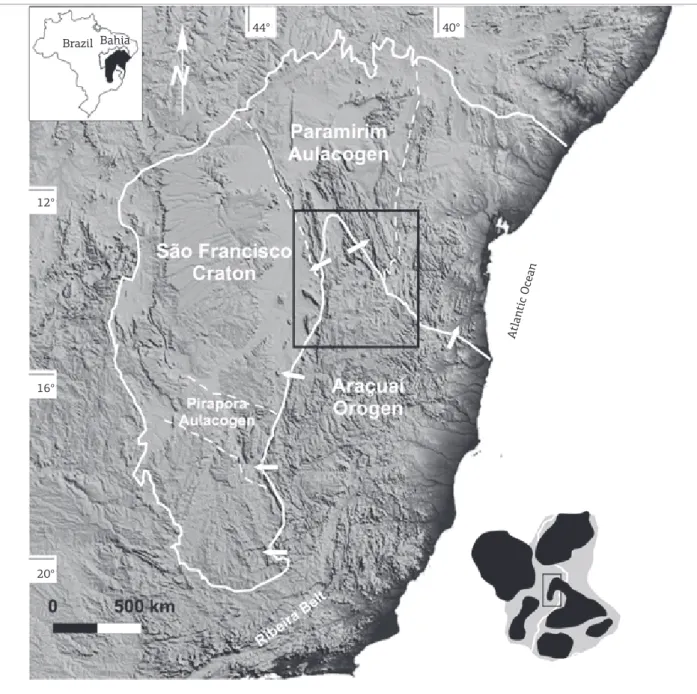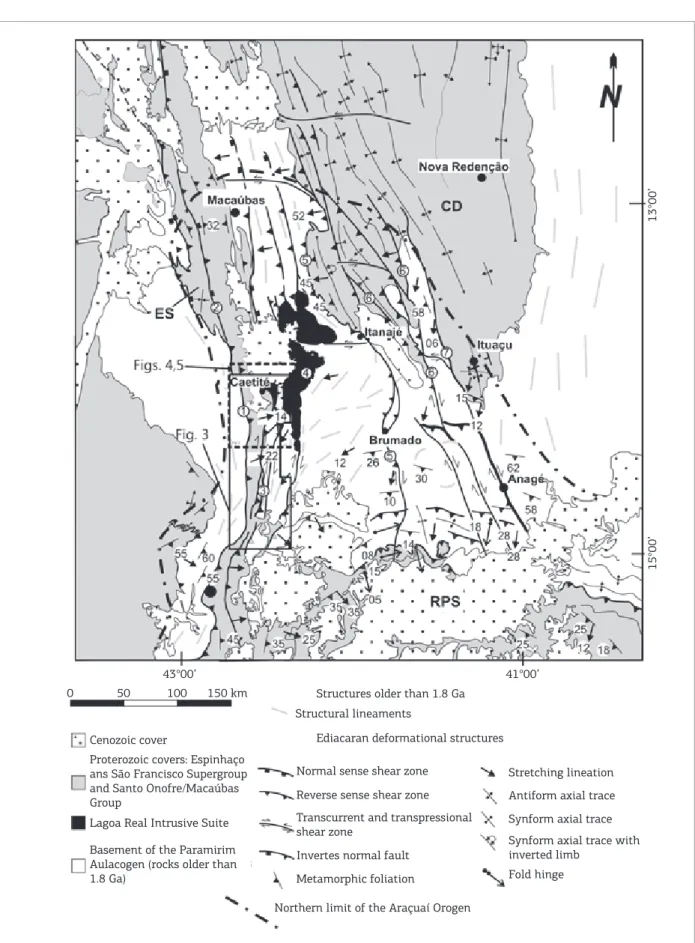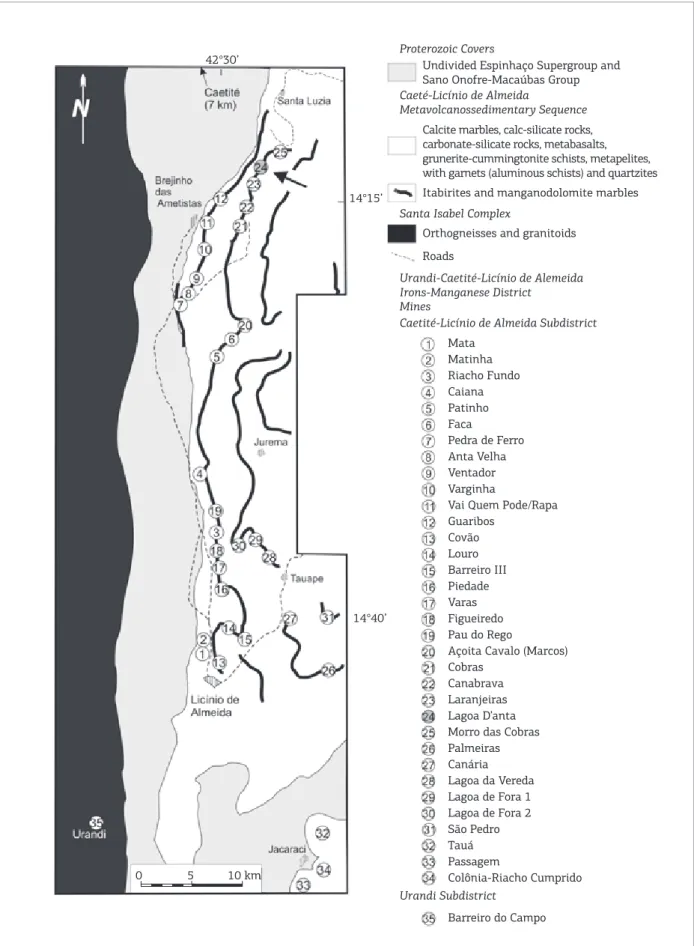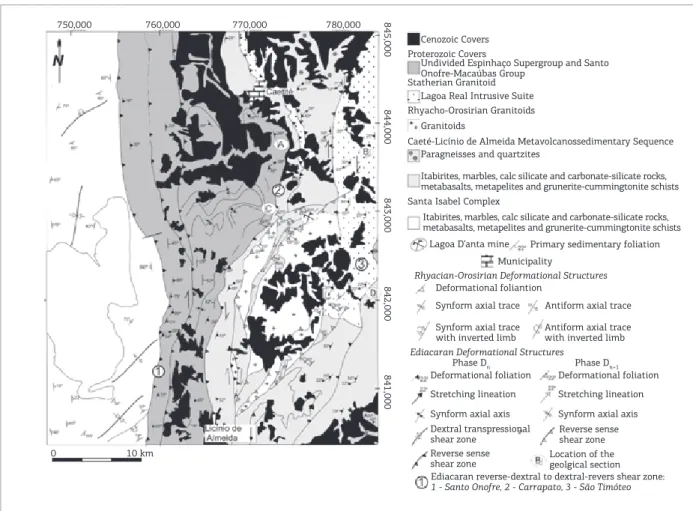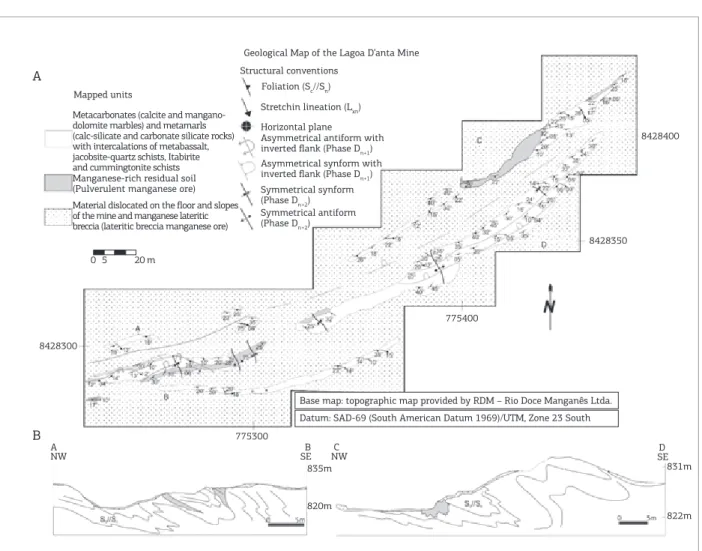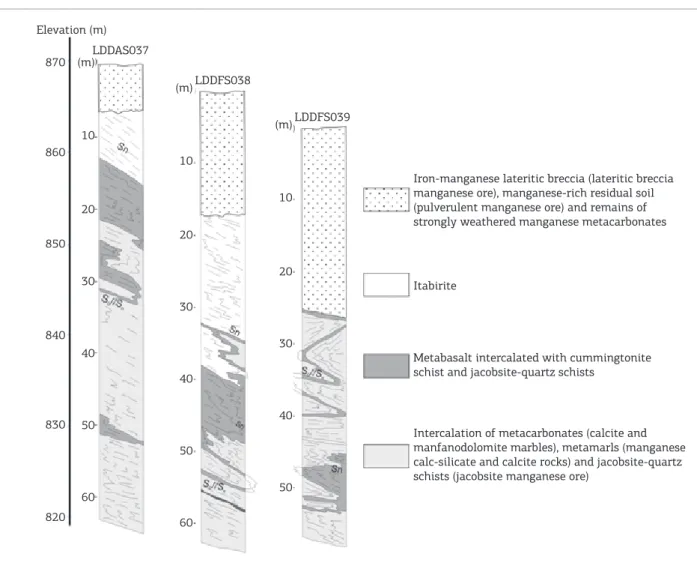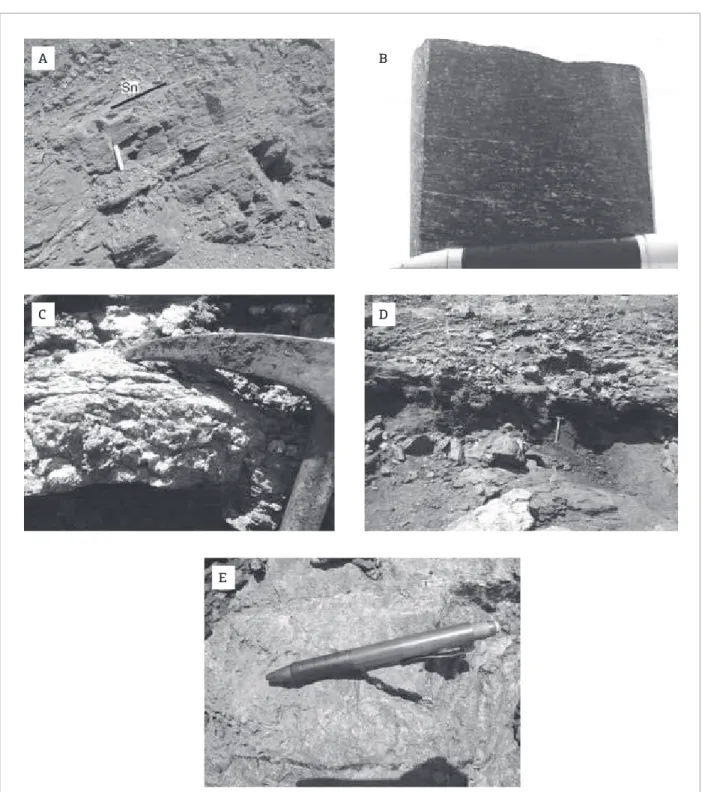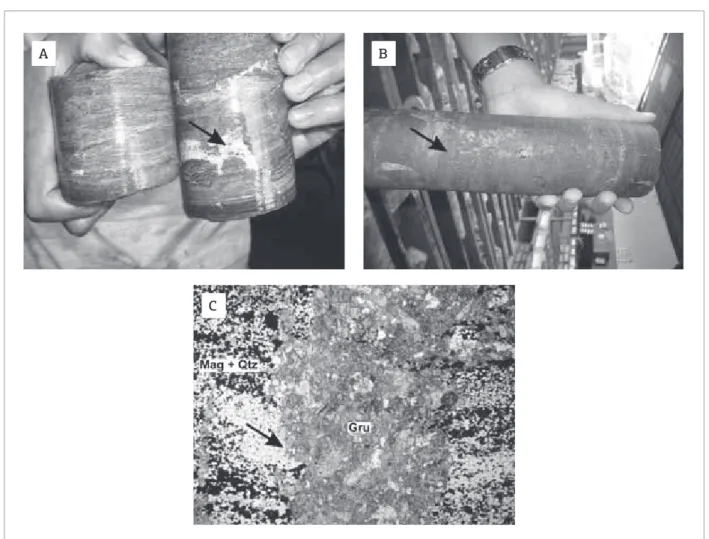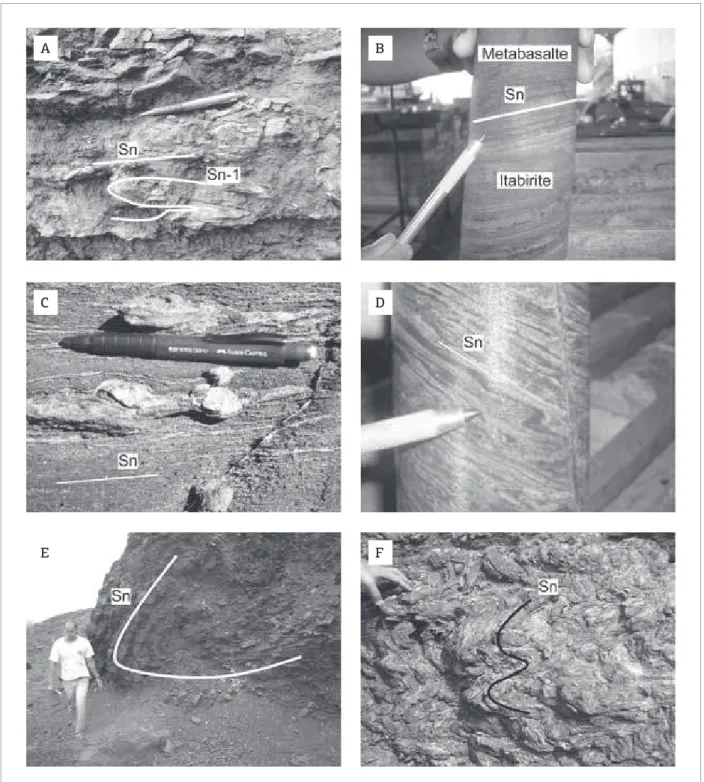1Programa de Pesquisa e Pós-Graduação em Geologia, Instituto de Geociências, Departamento de Geologia, Universidade Federal da Bahia – UFBA, Salvador (BA),
Brazil. E-mail: falecomjofre@gmail.com; simonecruzufba@gmail.com; johildo.barbosa@gmail.com
2Instituto de Geociências, Universidade Federal da Bahia – UFBA, Salvador (BA), Brazil. E-mail: edm.geo@gmail.com
*Corresponding author
Manuscript ID: 30183. Received: 10/14/2014. Approved: 03/26/2015. ABSTRACT: he Urandi-Caetité-Licínio de Almeida Iron-Man-ganese District encompasses a total of 35 manIron-Man-ganese mines, most of which are already exhausted, and 1 currently active iron mine. he host rocks of these ores are associated with the Paleoprotero-zoic Caetité-Licínio de Almeida Metavolcanossedimentary Sequence. hese units have been deformed by the northern Serra do Espinhaço hrust and Fold Belt, in the northern section of the Araçuaí Orogen. Interbeddings of itabirite, cummingtonite schist, calcite and man-ganese-dolomitic marbles, calc-silicate and carbonate-silicate rocks, and amphibolitic metabasalt were found at the Lagoa D’anta mine, in addition to quartz-jacobsite schist, residual manganese-rich soil and manganese lateritic breccia. he main structural framework presents a general NE-SW trend and it consists predominantly of compressional structures. his structural framework is associated with the evolution of two Ediacaran dextral transpressional shear zo-nes, the Carrapato zone, in the western portion, and São Timóteo zone, in the eastern portion. he structural framework of the Lagoa D’anta mine relects a higher degree of shortening in the southern sector of the northern Serra do Espinhaço hrust and Fold Belt, in the northern area of the Araçuaí Orogen. he ductile structures re-lated to these deformational phases were nucleated under conditions of progressive metamorphism with minimum temperature of 550°C. Stockwork structures of quartz, calcite, epidote, grunerite and mag-netite truncate the mine’s ductile structures. Fractures were the main circulation channels for meteoric water, which culminated in the for-mation of a high-content supergene ore in the mine.
KEYWORDS: structural framework; aulacogen; shear zones; deformation.
RESUMO: O Distrito Ferro-Manganesífero Urandi-Caetité-Licínio de Almeida congrega um total de 35 minas de manganês, a maioria exaurida, e 1 mina de ferro, em atividade, cujas rochas hospedeiras dos minérios estão associadas com a Sequência Metavulcanossedimentar-Caetité-Licínio de Almeida, de idade paleoproterozoica. Essas unidades encontram-se deformadas pelo Cinturão de Dobramentos e Cavalga-mentos Serra do Espinhaço setentrional, na porção norte do Orógeno Araçuaí. Na mina Lagoa D’anta, foram identiicadas intercalações de itabirito, cummingtonita xistos, mármore calcítico e manganodo-lomítico, rochas calcissilicáticas e carbonato-silicáticas, metabasalto anibolítico, além de quartzo-jacobsita xisto, solo residual rico em manganês e brecha laterítica manganesífera. O arcabouço estrutural principal apresenta trend geral NE-SW, sendo constituído dominante-mente por estruturas compressionais. Esse arcabouço está associado com a evolução de duas zonas de cisalhamento transpressionais destrais, de idade ediacarana, denominadas de Carrapato, a oeste, e São Timó-teo, a leste. O arcabouço estrutural na mina Lagoa D’anta relete um maior grau de encurtamento no setor sul do Cinturão de Dobramentos e Cavalgamentos Serra do Espinhaço setentrional, na porção norte do Orógeno Araçuaí. As estruturas dúcteis relacionadas com essas fases de-formacionais foram geradas em condições de metamorismo progressivo com temperatura mínima de 550°C. Estruturas stockwork de quartzo, calcita, epidoto, grunerita e magnetita truncam as estruturas dúcteis da mina. Fraturas foram os principais canais de circulação de água meteórica que culminou com a formação de um minério supergênico de alto teor na mina.
PALAVRAS-CHAVE: arcabouço estrutural; aulacógeno; zonas de cisalhamento; deformação.
Structural framework of rocks of the Lagoa
D’anta mine area, iron-manganese
Urandi-Caetité-Licínio de Almeida District, Bahia, Brasil
Arcabouço estrutural das rochas da mina Lagoa D’anta, distrito
ferro-manganesífero Urandi-Caetité-Licínio de Almeida, Bahia, Brasil
Jofre de Oliveira Borges1*, Simone Cerqueira Pereira Cruz1,
Johildo Salomão Figueiredo Barbosa1, Edmar da Silva Santos2
INTRODUCTION
he Lagoa D’anta mine is tectonically positioned in the Serra do Espinhaço Setentrional hrust and Fold Belt (Figs. 1 and 2), in the northern sector of the Araçuaí Orogen. In its southern sector, this belt presents structural elements that relect the inversion of the Paramirim Aulacogen (sensu
Pedrosa-Soares et al. 2001) during the Ediacaran due to col-lisions between the São Francisco-Congo, Paranapanema, Rio de la Plata and Amazonian plates. hese compressional deformations partially reworked structures older than 1.8 Ga that were described in the basement of the aulacogen by Figueiredo (2009), Cruz et al. (2009, 2014), Medeiros (2012), and Figueiredo et al. (2013).
he Caetité-Licínio de Almeida Metavolcanossedimentary Sequence (Cunha et al. 2012), which has not been dated yet, though according to Cruz et al. (2014) it is likely to be a Paleoproterozoic sequence, is one of the units of the south-ern sector of the Serra do Espinhaço Setentrional hrust and Fold Belt and of the basement of the Paramirim Aulacogen in the northern sector of the Araçuaí Orogen. his sequence hosts a total of 35 manganese mines (Fig. 3), most of which are already exhausted, and 1 iron mine, which is currently being exploited, comprising the Urandi-Caetité-Licínio de Almeida iron-manganese district (modiied from Rocha et al.
1998). For manganese, the general predominating protore is the manganese-dolomite marble, with or without spessar-tite, and subordinately, quartz-jacobsite schist (Borges 2012). Regarding iron, lenticular bodies of pulverulent hematite schist predominate, which are intercalated by itabirite levels. hese rocks underwent hydrothermal alteration mainly with magnetite enrichment and supergene alteration.
he irst manganese discoveries in the Serra do Espinhaço Setentrional hrust and Fold Belt were in 1948. he Lagoa D’anta mine was one of the most productive during the 1960’s and 1970’s. Despite the great advance of the mining fronts, this mine still represents an exuberant natural labo-ratory in which the rocks and deformational structures of the Caetité-Licínio de Almeida Metavolcanossedimentary Sequence are quite well-exposed.
he main objective of the present study was to present the structural framework of the Lagoa D’anta mine and correlate it with the regional tectonic framework in order to collaborate with the study of the tectonic evolution of the southern sector of the Serra do Espinhaço Setentrional hrust and Fold Belt and its basement, southwards from the municipality of Caetité, Bahia, Brazil (Fig. 2). his study is of great importance and complements the data obtained by Machado (1977, 1983), Moraes et al. (1980) and Souza et al.
(1984, 1990). Moreover, it presents an example of deforma-tion in transpressional belts similar to what has been modeled
by Wilcox et al. (1985), Sanderson and Machini (1994), Tikof and Peterson (1998), and Jones et al. (2004), and also described for various regions of the world by Cunningham (2005, 2013), Sarkarinejad and Azizi (2008), Santimano and Riller (2012), Sarkarinejad et al. (2013), among others.
REGIONAL GEOLOGICAL CONTEXT
he Serra do Espinhaço Setentrional hrust and Fold Belt, with maximum age dated as Cryogenian, is located in the northern sector of the Araçuaí Orogen and is positioned in the maximum inversion zone of the Paramirim Aulacogen (sensu Pedrosa-Soares et al. 2001), an extensional structure that evolved from approximately 1.7 to 0.67 Ga (Pedrosa-Soares & Alkmim 2011). his belt comprises units of the Gavião Block (sensu Barbosa & Sabaté 2002), which com-prise the basement of the Paramirim Aulacogen and the Lagoa Real Intrusive Suite, representatives of the plutonic rocks of the Statherian rift phase from the initial evolution of this aulacogen, as well as the units of metavolcanossedi-mentary rocks from the Espinhaço Supergroup and the Santo Onofre-Macaúbas Group (Figs. 2 and 4), which correspond to the cover units of the aulacogen. he Gavião Block is com-posed by the Gavião (Dalton de Souza et al. 2003) and Santa Isabel (Barbosa & Moutinho da Costa 1973) complexes, as well as metavolcanossedimentary sequences. In the Gavião Complex, there are outcrops of tonalite-trondhjemite-gra-nodiorite (TTG) orthogneisses, and Paleo-, Meso- and Neoarchean migmatites and granitoids (Cordani et al. 1985, 1992; Santos-Pinto 1996, Santos-Pinto et al. 1998; Bastos-Leal 1998, Peucat et al. 2002, Barbosa et al. 2012). In turn, the Santa Isabel Complex (Fig. 4) consists of tonalitic, gra-nodioritic and granitic orthogneisses, with amphibolite and metapyroxenite enclaves, as well as eclogites, kinzigitic gneisses, calc-silicate rocks, itabirites, serpentine marbles, schistiied meta-ultrabasic rocks and granulitic migmatites (Barbosa & Moutinho da Costa 1973; Portela et al. 1976, Arcanjo et al. 2000). he geochronological database pro-duced by Medeiros (2012) and Barbosa et al. (2013) sug-gests that these are in fact Mesoarchean rocks that were metamorphosed during the Rhyacian.
1977, 1983; Moraes et al. 1980; Rocha et al. 1998; Borges 2008, 2012; Cruz et al. 2009; Cunha et al. 2012).
he Archean rocks and the metavolcanossedimentary sequences of the Gavião Block are intruded by Rhyacian, Orosirian and Statherian granitoids (Turpin et al. 1988; Cordani et al. 1992; Arcanjo et al. 2000; Bastos-Leal 1998; Bastos-Leal et al. 2000; Menezes-Leal et al. 2005). In the case of these granitoids, deformation is preferentially embedded in shear zones originating orthogneisses or foliated granitoids. Regarding the Rhyacian-Orosirian granitoids, calc-alkaline and alkaline rocks predominate (Menezes-Leal et al. 2005)
with U-Pb ages that range between 2,324 ± 6 and 1,871 ±
180 (Martins 2014). In turn, the Lagoa Real Intrusive Suite encompasses syenites, alkali feldspar granites and syenogran-ites. hese alkaline rocks are from the continental intraplate environment (Teixeira 2000; Machado 2008) and mark the initial installation phase of the Paramirim Aulacogen (sensu
Pedrosa-Soares et al. 2001). U-Pb (zircon and titanite) ages of approximately 1.7 Ga were obtained for these rocks by Turpin et al.(1988), Cordani et al. (1992), Pimentel et al.
(1994) and Cruz et al. (2007a) and were interpreted as being a result of the crystallization of this suite.
44° Brazil Bahia
12°
16°
20°
Atlantic Ocean 40°
Figure 1. The Araçuaí Orogen in the Gondwana scenario, rebuilt through the juxtaposition of digital terrain models from the eastern sector of Brazil. The white arrows represent the vergence of the deformations of the
0 50 100 150 km Structures older than 1.8 Ga
Northern limit of the Araçuaí Orogen
Fold hinge
Synform axial trace with inverted limb
Synform axial trace Antiform axial trace Stretching lineation
Metamorphic foliation Invertes normal fault
Transcurrent and transpressional shear zone
Reverse sense shear zone Normal sense shear zone
Ediacaran deformational structures Structural lineaments
Basement of the Paramirim Aulacogen (rocks older than 1.8 Ga)
Lagoa Real Intrusive Suite Proterozoic covers: Espinhaço ans São Francisco Supergroup and Santo Onofre/Macaúbas Group
Cenozoic cover
43°00’ 41°00’
15°00’
13°00’
Figure 2. Map of the northern sector of the Araçuaí Orogen with the main structural traces. Modiied from Cruz
(2004). The boxes show the location of Figs. 3 to 5.
42°30’ Proterozoic Covers
Caetité-Licínio de Almeida Subdistrict
Urandi Subdistrict Mines
Urandi-Caetité-Licínio de Alemeida Irons-Manganese District
Santa Isabel Complex Caeté-Licínio de Almeida
Metavolcanossedimentary Sequence
Cobras
Barreiro do Campo
0 5 10 km Colônia-Riacho Cumprido
Passagem Tauá São Pedro Lagoa de Fora 2 Lagoa de Fora 1 Lagoa da Vereda Canária Palmeiras Morro das Cobras Lagoa D’anta Laranjeiras Canabrava
Açoita Cavalo (Marcos) Pau do Rego
Figueiredo Varas Piedade Barreiro III Louro Covão Guaribos
Vai Quem Pode/Rapa Varginha
Ventador Anta Velha Pedra de Ferro Faca
Patinho Caiana Riacho Fundo Matinha Mata Roads
Orthogneisses and granitoids
Itabirites and manganodolomite marbles Calcite marbles, calc-silicate rocks, carbonate-silicate rocks, metabasalts, grunerite-cummingtonite schists, metapelites, with garnets (aluminous schists) and quartzites Undivided Espinhaço Supergroup and Sano Onofre-Macaúbas Group
14°15’
14°40’
he Espinhaço Supergroup, of Statherian-Calymmian age, comprises a siliciclastic sequence with metavolcanic felsic rocks with crystallization ages (U-Pb, SHRIMP) of 1,731 ±
5 and 1,582 ± 8 Ma (Danderfer Filho et al. 2009). A crys-tal tuf sample from the Tombador Formation was dated by Guadagnin et al. (2015) at 1,436 ± 26 Ma. he Santo Onofre-Macaúbas Group, on the other hand, of Tonian age (Babinski et al. 2011), comprises feldspar meta-arenites and meta-quartz arenites, oligomictic metaconglomerates, phyl-lites, and hematite, graphite and/or manganese and sericite metapelites (Guimarães et al. 2012). hese rocks are trun-cated by gabbroic and tholeiitic maic dykes, distinguished through U-Pb (zircon) data in two groups of diferent ages — Group I: 1,492 ± 16 Ma (Loureiro et al. 2010); 1,514 Ma (Babinski et al. 1999) and 1,496 Ma (Guimarães et al. 2005); Group II: 854 ± 23 Ma (Danderfer Filho et al. 2009) and 834 Ma (Loureiro et al. 2010).
In a regional scope, the studies performed by Cruz and Alkmim (2006) and Cruz et al. (2012) suggest the existence of three deformational structure groups in the northern sector of the Araçuaí Orogen:
1. structures older than the Paramirim Aulacogen, which are exclusive to the basement of the aulacogen. In other words, these structures reflect the Archean and/or Paleoproterozoic evolution of the Gavião Block. In the Santa Isabel Complex, located westwards from the Serra do Espinhaço Setentrional hrust and Fold Belt (Fig. 4), Medeiros (2012) identiied sinistral folds and shear zones, with general NNE-SSW to NE-SW orientation, which relect a tension ield oriented NW-SE. Westwards from this belt, gneissic banding, open to closed folds and dome structures predominate (Cruz 2004; Cruz et al. 2009);
2. extensional structures related to the evolution of the Paramirim Aulacogen, since the Statherian until the Stenian, which are preserved to the north of parallel 12° 45’ S and to the south of parallel 12° 15’ S. his struc-ture family comprises normal and dextral-normal shear zones (Danderfer Filho 2000) that evolved between 1.7 and 0.67 Ga (Pedrosa-Soares & Alkmim 2011); and
3. structures related to the inversion of the Paramirim Aulacogen, which are partly the subject of the present study and which reworked the previous structures (Figs. 2, 4 and 5).
Caeté-Licínio de Almeida Metavolcanossedimentary Sequence
Santa Isabel Complex
Lagoa D’anta mine
Deformational foliantion
Synform axial trace Antiform axial trace
Synform axial trace with inverted limb
Reverse sense shear zone
Reverse sense shear zone Location of the geolgical section Ediacaran reverse-dextral to dextral-revers shear zone:
1 - Santo Onofre, 2 - Carrapato, 3 - São Timóteo
Dextral transpressional shear zone
Synform axial axis Stretching lineation Deformational foliation
Synform axial axis Stretching lineation Deformational foliation Phase Dn Phase Dn+1
Antiform axial trace with inverted limb Primary sedimentary foliation
Municipality
Rhyacian-Orosirian Deformational Structures
Ediacaran Deformational Structures
Rhyacho-Orosirian Granitoids 750,000 760,000 770,000 780,000 845,000
844,000
843,000
842,000
841,000
0 10 km
Proterozoic Covers
Statherian Granitoid
Undivided Espinhaço Supergroup and Santo Onofre-Macaúbas Group
Paragneisses and quartzites
Itabirites, marbles, calc silicate and carbonate-silicate rocks, metabasalts, metapelites and grunerite-cummingtonite schists
Itabirites, marbles, calc silicate and carbonate-silicate rocks, metabasalts, metapelites and grunerite-cummingtonite schists Granitoids
Lagoa Real Intrusive Suite Cenozoic Covers
Figure 4. Geological map of the Serra do Espinhaço Setentrional Thrust and Fold Belt, southwards from the
municipality of Caetité. The arrow indicates the location of the Lagoa D’anta mine. Modiied from Cruz et al.
hey comprise shear zones that are generally oriented NNW-SSE, as well as reverse, reverse-dextral or dextral movements and folds. According to Cruz and Alkmim (2006) and Cruz
et al. (2012, 2014), these shear zones truncate or reuse the deformations older than 1.8 Ga present in the basement units of the aulacogen, as well as the rocks from the Lagoa Real Intrusive Suit, from the Espinhaço and São Francisco Supergroups and the Santo Onofre-Macaúbas Group. Ar-Ar ages between 483 and 586 Ma were obtained from phyllosilicates of the rocks hosted in the São Timóteo and Brumado-Paramirim shear zones (Fig. 2) by Bastos-Leal (1998), Cordani et al. (1992) and Guimarães et al. (2005). Moreover, in the Chapada Diamantina hrust and Fold Belt, displays of the João Correia-Barra do Mendes shear zones truncate rocks of the Salitre Formation (Cruz & Alkmim 2006). his formation can be correlated to the Sete Lagoas Formation, in the São Francisco Basin, which was dated by Babinski et al. (2007) through Pb-Pb isochronic dating as 740 ± 22 Ma. hus, it was possible to establish the maxi-mum age for the shear zones associated with the inversion of the Paramirim Aulacogen. Southwards, in the Araçuaí Orogen, these shear zones truncate the Tonian units of the Macaúbas Group (Babinski et al. 2011).
The folds related to the inversion of the Paramirim Aulacogen have various geometries, but in general they are open, normal-horizontal (sensu Fleuty 1964) and are observed in micro, meso and macro scales (Danderfer Filho1990, 2000; Cruz & Alkmim 2006; Bittencourt 2014). hese folds are observed in units of the Espinhaço and São Francisco Supergroups, as well as in the Santo-Onofre-Macaúbas Group, in cover units of the Paramirim Aulacogen, and in the metavolcanossedimentary sequences of its basement. In the Caetité area, and associated with the units of the Santo Onofre-Macaúbas Group, Bittencourt (2014) mapped a mega refolded fold feature (sensu Ramsay & Hubber 1987) involving graphite and aluminous schists with biotite, gar-net, staurolite and quartz (Fig. 4). According to Cruz and Alkmim (2006), Cruz et al. (2012) and Bittencourt (2014), these structures relect a WSW-ENE oriented shortening ield.
GEOLOGY OF THE LAGOA D’ANTA MINE
Lithological units
he geological mapping of the Lagoa D’anta mine (Fig. 6) was performed in this study at a scale of 1:1,000 and the main Figure 5. Schematic geological-structural sections transversal to the Serra do Espinhaço Setentrional Thrust and
Fold Belt. The locations of the sections, as well as the legend of the units, are shown in Fig. 4.
A
A B
C 0 1 km D
B
Statherian Granitoid Proterozoic Covers
Cenozoic Covers
Reverse sense shear zone
Rhyacian-Orosirian Granitoids
Caetité-Licínio de Almeida Metavolcanossedimentary Sequence Granitoids
Itabirites, marbles, calc-silicate and carbonate-silicate rocks, metabasalts, metapelites and grunerite-cummingtonite schists Paragneisses and quartzites
Strutural lineament Dextral transpressional shear zone Lagoa Real intrusive suite
Undivided Espinhaço Supergroup and SantoOnofre-Macaúbas Group
focus was to delimitate the manganese ore bodies and gather information on the structural framework. his study allowed the mapping of the rocks adjacent to the magnesium miner-alization (itabirite, cummingtonite-schist, metabasalt, calcite marble, calc-silicate and carbonate-silicate rocks) and the host rocks for the mineralization, which comprise the mine’s man-ganese protore (manman-ganese-dolomite marble with or without spessartite, jacobsite-quartz schist, as well as carbonate-silicate and calc-silicate rocks with manganese-dolomite and spessa-rtite) (Borges 2012). Moreover, the soil is rich in manganese and is associated with the following types of ores (Fig. 7):
1. pulverulent, which is lenticular, with irregular geometry and erratic distribution; and
2. lateritic breccia. hese ores are the product of super-gene alteration of the aforementioned manganese pro-tore in the mine.
Cummingtonite-schist and itabirite (Fig. 8A) occurred forming various levels and presented thickness of 1 and 15 m, respectively. hese rocks have variable proportions
Geological Map of the Lagoa D’anta Mine
Structural conventions
Foliation (Sc//Sn) Stretchin lineation (Lxn) Horizontal plane
Asymmetrical antiform with inverted flank (Phase Dn+1)
Symmetrical synform (Phase Dn+2)
Symmetrical antiform (Phase Dn+2)
Datum: SAD-69 (South American Datum 1969)/UTM, Zone 23 South Base map: topographic map provided by RDM – Rio Doce Manganês Ltda.
775400
775300 8428300
B
A B C
NW SE SED
835m 831m
822m 820m
NW
8428350
8428400
Asymmetrical synform with inverted flank (Phase Dn+1)
Mapped units
Metacarbonates (calcite and mangano-dolomite marbles) and metamarls (calc-silicate and carbonate silicate rocks) with intercalations of metabassalt, jacobsite-quartz schists, Itabirite and cummingtonite schists
Material dislocated on the floor and slopes of the mine and manganese lateritic breccia (lateritic breccia manganese ore)
0 5 20 m Manganese-rich residual soil (Pulverulent manganese ore) A
Figure 6. (A) Geological map of the Lagoa D’anta mine. (B) Geological sections showing the vergence to NW of the Fn+1 folds and the position of the manganese ore bodies.
Hydrothermal minerals, both in the country rocks and in the protore, are present in the veins of quartz, calcite (Fig. 10A), epidote grunerite (Fig. 10B) and magnetite (Fig. 10C) that truncate ductile structures.
Manganese mineralization
he manganese ore is represented by a residual soil that presents up to 66.80% of MnO2, comprising the high content ore of the mine (Fig. 8D), and is characterized as a pulverulent type of ore. he thickness of this mineralized zone is variable, ranging from 5 to 12 m. A lateritic breccia ore also occurs, with up to 42% of MnO2 and thickness reaching 15 m, which is possibly related to alluvial fans that were altered by super-gene processes. According to Borges (2012), jacobsite-quartz schist, manganese-dolomite marbles with or without spessa-rtite, as well as carbonate-silicate and calc-silicate rocks with manganese-dolomite and spessartite were altered by supergene processes that led to the observed concentration of MnO (Fig.
8D) and to the creation of a pulverulent ore. his ore is rich in cryptomelane (Figs. 9E and 9F) and is frequently associated with a siliceous microcrystalline material (Fig. 8E), which is a result of the supergene alteration from garnet to manganese oxide, denominated siliceous (Borges 2012) alteroplasma (sensu
Delvigne 1998). Supericial processes seem to have contributed towards the creation of manganese lateritic breccia by means of the installation of alluvial fans, manganese lixiviation and supergenesis. Mineralization age has not been determined yet.
Structural framework
According to Cruz et al. (2009), the Lagoa D’anta mine is positioned between two shear zones (Figs. 2 and 4) called Carrapato (Danderfer Filho 2000), or Eastern Border (Rocha
et al. 1998), and São Timóteo (Cruz 2004; Cruz & Alkmim 2006; Cruz et al. 2012). In this sector of the Serra do Espinhaço Setentrional hrust and Fold Belt, these shear zones present a general N-S orientation, NE and SW dips, respectively with
Elevation (m)
LDDAS037
870 (m)
10
20
30
40
50
60
LDDFS038 (m)
10
20
30
40
50
60
LDDFS039
Intercalation of metacarbonates (calcite and manfanodolomite marbles), metamarls (manganese calc-silicate and calcite rocks) and jacobsite-quartz schists (jacobsite manganese ore)
Metabasalt intercalated with cummingtonite schist and jacobsite-quartz schists
Itabirite
Iron-manganese lateritic breccia (lateritic breccia manganese ore), manganese-rich residual soil (pulverulent manganese ore) and remains of strongly weathered manganese metacarbonates (m)
10
20
30
40
50 860
850
840
830
820
Figure 7. Lithological proiles of the Lagoa D’anta mine in drill holes located in the surrounding area. Note the
values ranging between 20° and 45°. From north to south, the movement varies from reverse-dextral to dextral-reverse (Cruz & Alkmim 2006; Cruz et al. 2009, 2014; Bittencourt 2014). he main movement indicators observed on the XZ plane are S/C/C’ structures. When shear zones develop in granitoids, delta and sigma structures are created. In these shear zones, the stretch-ing lineation ranges, in general, from medium to low obliquity
and is preferentially oriented 053°/43°. he geological sections presented in Fig. 5A suggest the existence of a transpressional pop-up structure generally N-S oriented encompassing the units of the Caetité-Licínio de Almeida Metavolcanossedimentary Sequence, the Lagoa Real Intrusive Suite, as well as the units of the Espinhaço Supergroup and Santo Onofre-Macaúbas Group in the Serra do Espinhaço Setentrional hrust and Fold Belt.
A
C
E
B
D
Figure 8. Mapped lithologies in the Lagoa D’anta mine. (A) Itabirite. (B) Metabasalt. (C)
A
C
E
B
D
F
Figure 9. Photomicrographs showing the microstructures and minerals observed in rocks from the Lagoa D’anta mine. (A and B) Polygonal granoblastic microstructure in itabirite and manganese-dolomite marble, respectively. (C and D) Nematoblastic microstructure in cummingtonite-schist and metabasalt, respectively. (E and F) Cryptomelane generated through the alteration of manganese-dolomite marbles with spessartite.
Between the Carrapato and São Timóteo shear zones (Fig. 4), there are reverse subsidiary shear zones, with gen-eral NE-SW orientation, which truncate the N-S struc-tures. hese subsidiary zones also present double vergence and are possibly associated with another pop-up structure, though they are obliquely positioned in relation to regional structures. In this region, the dip of the shear zones ranges between 30° and 60°, while the stretching lineation presents high obliquity. In the NW branch, in the surroundings of the Lagoa D’anta mine, a slightly tilted (sensu Fleuty 1964), closed and horizontal synform fold was mapped by Cruz
et al. (2009). his fold is positioned between two shear zones that comprise the NW branch of the pop-up structure with NE-SW orientation, as shown in Fig. 5B.
Characterization of the deformational structures of the Lagoa D’anta mine
he structural survey led to the identiication of a set of ductile and brittle structures. he oldest deformational
structure was a compositional banding (S0//Sn-1) observed in rootless intrafolial isoclinal folds and transposed by Sn foliation (Fig. 11A). he banding (S0//Sn-1) is characterized by the alternation of manganese-dolomite marbles, calc-sil-icate rocks, metabasalt and itabirite. Garnet and grunerite, as well as carbonates and polygonal granoblastic micro-structure plagioclase, are observed associated with this S0// Sn-1 surface. Schistosity is observed parallel to this banding (Sn-1), present in rocks with amphibolites.
he dominant structure of the mine is Sn schistosity (Figs. 6, 8A and 11B). his feature is also parallel to a compositional banding (S0//Sn) that alternates the rocks from the Lagoa D’anta mine (Figs. 6, 7, 11B and 11D). In general, Sn is ori-ented NE-SW and the dip of these structures range between 0° and 40°, with maximum plane at 155°/18° (Fig. 12A). Sn schistosity is characterized by the preferred orientation of:
1. grains of cummingtonite and quartz in itabirite;
2. grains of cummingtonite in cummingtonite-schists (Fig. 9C);
A
C
B
Figure 10. Macroscopic aspects of the calcite (A, arrow) and magnetite (B, arrow) veins truncating Sn foliation in
metabasalt. In (C), we can observe the photomicrograph of a grunerite vein (Gru, arrow) truncating levels with
A
C
E
B
D
F
Figure 11. Deformational structures of the Lagoa D’anta mine. (A) Rootless isoclinal intrafolial fold involving S0//Sn-1 in a calc-silicate rock. (B) Compositional banding (S0//Sn) by the alternation of levels that are rich in
cummingtonite schist and metabasalt. (C) Symmetrical boudin of a quartz vein in spessartite-tremolite manganese-dolomite marble. (D and E) Parasitic asymmetrical folds in a drill hole and in an outcrop, respectively, in itabirite. (F) Parasitic symmetrical fold in a calc-silicate rock.
3. grains of cummingtonite and tremolite-actinolite in marbles, calc-silicate and carbonate-silicate rocks; and
4. grains of tremolite and magnesiohornblende in meta-basalt (Fig. 9D).
his structure is oriented subparallel to the intersection lin-eation between foliations Sn-1 and Sn.
Quartz levels and levels parallel to Sn are boudinaged not only on the XY plane of the foliation, but also on the XZ plane (Fig. 11C). In general, boudins presented 5 to 10 cm in length, were symmetrical and associated with pinch-and-swell structures and to passive folding (sensu
Fossen 2010), in this case, the folds were settled between the boudins.
he Sn foliation is folded in three hierarchical scales. he main envelopment of folding phase Fn+1 is a weakly tilted horizontal mega-synform fold (sensu Fleuty 1964) (Fig. 6) with wavelength of approximately 3 km. he axial plane dips towards SE and, thus, vergence is oriented towards NW. No axial plane foliation was found in this structure and one of the lanks of this fold is inverted. he parasitic folds range from being recumbent to weakly tilted horizontal and are non-cylindrical, disharmonic and present a closed curved
Lagoa D’anta mine Foliation Sn-1//Sn Maximum: 335°/71° Maximum plane: 155/18
A B
C Lagoa D’anta mine D
Hinge of fold Lbn+1
Maximum: 056°/10°
n = 21 n = 31
n = 170
2% 4% 6% 8% 10% 12% 14% 16% 18% 20%
2% 4% 6% 8% 10% 12% 14% 16% 18% 20% 22%
1% 5% 10% 14% 19% 24% 29% 34% 38% 41%
4% 10% 16% 23% 29% 36% 43% n = 38
Lagoa D’anta mine Hinge of fold Lbn+2
Maximum: 153°/40° Lagoa D’anta mine Stretching lineation: Lxn
Maximum: 093°/15°
Figure 12. Stereographical representation of the mapped structures of the Lagoa D’anta mine. (A) Polar isodensity diagram for the foliation planes (Sn). (B) Isodensity diagram for the stretching lineation (Lxn).
(C) Isodensity diagram for the hinge line (Lbn+1). (D) Isodensity diagram for the hinge line (Lbn+2). Lower hemisphere,
hinge (sensu Fleuty 1964). hese folds, which present higher hierarchy and have wavelengths of up to 10 m long, repre-sent parasitic structures of the regional folds mapped in the NW branch of the pop-up structure with NE-SW orien-tation (Fig. 5B). hese second-order folds were mapped in the scale of the mine and host third-order parasitic struc-tures, which are asymmetrical in S and Z and symmetrical in M (Figs. 11D, 11E and 11F). he hinge lines of these structures are preferentially oriented at 056°/10° (Fig. 12C). A second set of folds (Fn+2) can be found in the mine where the hinges are generally oriented NW-SE. In this case, the folds are smooth to open, disharmonic, with hinges at a general 153°/40° orientation, and with a subvertical axial plane (Fig. 12D). hese are classiied as moderately tilted (sensu Fleuty 1964). Wavelengths ranged between 30 and 120 m. hese structures present general NW-SE orientation (Fig. 6); in other words, en èchelon regarding the Carrapato and São Timóteo shear zones, both of which are dextral transpressional shear zones.
Veins are distributed in a non-systematic display, mainly forming quartz, calcite (Fig. 10A), epidote, grunerite (Fig. 10B) and magnetite (Fig. 10C) stockwork structures that truncate the previously described ductile structures. he veins measured from 0.1 to 5 cm in width and up to 10 cm in length. he formation of these structures is related to late hydrothermal activity in the development of both genera-tions of folds found in the mine.
In the mine, NE-SW and NW-SE fracture families trun-cate the folds. An intense association between supergene alteration zones and the presence of fractures is observed especially where the protore still predominates. In these sec-tors, narrow levels of cryptomelane are observed (Fig. 9E and 9F) associated with these brittle structures. In the domains with the greatest supergene alteration, this relationship is disguised by the presence of a pulverulent material that reaches 62.8% of MnO (Borges 2012).
STRUCTURAL EVOLUTION
AND REGIONAL CORRELATION
he structural survey performed in the present study allowed the identiication of four deformational compressional phases. he irst one (Dn-1) is associated with the presence of compositional banding (S0//Sn-1) and schistosity (Sn-1), which were found in rootless intrafolial isoclinal folds. Considering the scale of the mine, this compositional banding is transposed by a Sn schistosity that hosts mineral stretching lineation (Lxn), both of which are from phase Dn. hese structures were gener-ated through the development of inter- and intra-strata shear zones, which in turn are associated with the Carrapato and São Timóteo shear zones. In the Lagoa Real Intrusive Suites
and units of the Santo-Onofre Group, stretching lineation is oriented NE-SW to SSW-NNE (Fig. 4), while in the Caetité-Licínio de Almeida Metavolcanossedimentary Sequence, this lineation is generally oriented NE-SW to E-W. he distri-bution of planar and linear structures suggests the existence of a pop-up structure oriented N-S (Fig. 5A). As shortening increased and under transpressional conditions, another struc-ture of phase Dn+1 was formed, comprising a pop-up structure oriented NE-SW (Fig. 5B). he formation of this structure culminated in the development of reverse shear zones, which caused the thrust of Rhyacian granitoids over the Caetité-Licínio de Almeida Metavolcanossedimentary Sequence in the west branch of the pop-up structure(Fig. 5B), as well as culminated in the formation of Fn+1 folds.
hese structures from phases Dn and Dn+1 of the base-ment of the Serra do Espinhaço Setentrional hrust and Fold Belt correspond to the structures from phase Dp described by Cruz and Alkmim (2006), which were interpreted by these authors as being related to the inversion of the Paramirim Aulacogen. According to the same authors, southwards from the municipality of Caetité, shear zones with reverse-dex-tral to dexreverse-dex-tral-reverse movements predominate and, fur-ther south, at the latitude of the Lagoa D’anta Mine, shear zones with dextral-reverse movement predominate. hese structures are thought to be related to the involvement of the basement of the Paramirim Aulacogen in the defor-mation of the Espinhaço Supergroup, the São Francisco Supergroup and the Santo-Onofre-Macaúbas Group (cover units of the aulacogen), as well as the Lagoa Real Intrusive Suite during the Ediacaran. he involvement of the base-ment during the inversion of this sector of the Paramirim Aulacogen occurred through the activation of shear zones with reverse-dextral to dextral-reverse movement, called Carrapato and São Timóteo (Fig. 4), which truncate the con-tact between the basement and the aulacogen cover, as well as through the development of folds in the Caetité-Licínio de Almeida Metavolcanossedimentary Sequence. During this inversion, according to Cruz and Alkmim (2006), other transpressional shear zones were also activated, such as the Santo Onofre, Muquém, Paramirim-Brumado, Cristalândia and João Correia-Barra do Mendes shear zones (Fig. 2).
during the inversion of the Paramirim Aulacogen. As previously mentioned, ages between 483 and 586 Ma were obtained in phyllosilicates of rocks from other shear zones of this same sector of the Araçuaí Orogen by Bastos-Leal (1998), Cordani
et al. (1992) and Guimarães et al. (2005).
At the Lagoa D’anta mine, the deformational history asso-ciated with the evolution of the Carrapato and São Timóteo shear zones is more complex when compared to the other sec-tors of the Serra do Espinhaço Setentrional hrust and Fold Belt and involves the nucleation of structures related to more than one deformational phase, namely Dn and Dn+1. In other words, while to the north of the mines the structures related to these shear zones suggest the existence of only one phase, Dn, in the area of the mine, more than one deformational phase were observed. he structures of phase Dn+1 truncate those from phase Dn, which present regional distribution. In this case, a pop-up structure oriented NE-SW was formed, as well as centrifugal vergence towards NW and SE. his structure is oblique in relation to the Carrapato and São Timóteo shear zones and was responsible for the thrusting of the units of the Caetité-Licínio de Almeida Metavolcanossedimentary Sequence (basement of the Paramirim Aulacogen) over the Tonian units of the Santo Onofre-Macaúbas Group (sedimen-tary cover of the Paramirim Aulacogen) and of the Rhyacian granitoids (Cruz et al. 2009) over the Statherian rocks of the Lagoa Real Intrusive Suite (Fig. 5) (Cruz & Alkmim 2006; Cruz et al. 2007a, 2009, 2014; Bittencourt 2014).
In N-S dextral transpressional systems, structures ori-ented NE-SW should be extensional, not compressional as those observed in the area of the Lagoa D’anta Mine. he presence of a pop-up structure oriented NE-SW in the identiied transpressional system suggests:
1. deformation controlled by the reactivation of old base-ment structures, such as the transference zones of the Paramirim Aulacogen or shear zones older than 1.8 Ga, with general NE-SW orientation. Basement inheritance is thought to control deformation given the strong simi-larity between the trend of structures older than 1.8 Ga (obtained by Medeiros (2012) in the Santa Isabel Complex, westwards from the Espinhaço Setentrional hrust and Fold Belt; Fig. 4) and the NE-SW orientation of the pop-up structure mapped in the present study;
2. deformation partitioning into sectors with oblique pressional shear zones oriented N-S and frontal com-pressional shear zones oriented NE-SW; and
3. the intensity of regional shortening. he increase in deformation from north to south at the northern sector of the Araçuaí Orogen has already been shown in stu-dies conducted by Moutinho da Costa and Inda (1982), Danderfer Filho (1990, 2000), Cruz and Alkmim (2006) and Cruz et al. (2007b).
he progression of deformation and maintenance of the WSW-ENE tension ield is believed to have led to the development of open folds in phase Dn+2. hese folds are considered to be non-coaxial in relation to the folds from phase Dn+1 and are distributed en èchelon in relation to the São Timóteo and Carrapato shear zones, as well as con-trolled by regional tensions. he geometric arrangement obtained for phase Dn+2, in which there is the develop-ment of NE-SW oriented folds that are moderately tilted (sensu Fleuty 1964) and obliquely positioned in relation to the Carrapato and São Timóteo dextral-reverse transpres-sional shear zones (both with N-S orientation; Fig. 13), is similar to the model for Wrench Folds, produced in lab-oratory by Wilcox et al. (1985). However, in the area of the Espinhaço Setentrional hrust and Fold Belt, located southwards from the municipality of Caetité (Fig. 2), the Carrapato and São Timóteo shear zones are not vertical, as expected in the model by Wilcox et al. (1985), but tilted, as expected in the models by Tikof and Teyssier (1994), Jones et al. (2004) and Sarkarinejad et al. (2013). Moreover, the Fn+2 folds are moderately tilted (sensu Fleuty 1964) and not normal-horizontal as expected in the model by Wilcox
et al. (1985). his probably occurs because the folds from this phase developed on a tilted surface, which was previ-ously folded by phase Dn+1, unlike the model proposed by the author, which considers horizontal layers.
cummingtonite, magnetite and quartz in itabirites, magnesio-hornblende and andesine comprising a polygonal granoblastic structure in spessartite metabasalts, manganocummingtonite and mangano-dolomite in marbles (Borges 2012). On the other hand, in the surroundings of Caetité, Bittencourt (2014) obtained mineral paragenesis with garnet, biotite and staurolite
Continental Scale
A
B C
Areas affected by the Ediacaran deformation
phase Dn-1
phase Dn
Deformational phase - Dn+1
Deformational phase - Dn+2
Ediacaran reverse shear zonen - Phase Dn+1
Ediacaran dextral transpressional shear zonen - Phase Dn
Stretching lineation Lxn+1
Stretching lineation Lxn
Maximum main tension Vergence
Dextral shear sense
Foliation - Sn+1 Foliation - Sn
Lxn
Lxn
Lxn
Lbn+1
Sn-1//Sn Sn-1 Regional scale
?
SSZ CSZ
Basement heritage
Mine scale
Figure 13. Deformational evolution model proposed for the Lagoa D’anta mine and regional correlation at
continental (A), regional (B) and mine (C) scales. The legend of Fig. B is equal to the legend of Fig. 5.
AO: Araçuaí Orogen; BO: Brasília Orogen; RPO: Rio Preto Orogen; RPO: Riacho do Pontal Orogen; SEO: Sergipano Orogen; CSZ: Carrapato Shear Zone; SSZ: São Timóteo Shear Zone.
between 580 and 745°C for the syntectonic metamorphism of the Lagoa Real Intrusive Suite associated with the evolu-tion of the São Timóteo shear zone. Both in the Carrapato shear zone, especially in the rocks of the Lagoa D’anta mine, and in the São Timóteo shear zone, syntectonic plagioclase recrystallization suggests temperature conditions higher than 550°C (White 1976; Tullis et al. 1982; Urai et al. 1986; Hirth & Tullis 1992). he presence of tremolite crowning magne-siohornblende in metabasalt suggests retrometamorphic con-ditions of greenschist facies late to Dn+1.
At the scale of the mine, brittle structures stored hydrother-mal luids which were responsible for the creation of stockwork structures and veins of calcite, grunerite and magnetite. Speciic studies have not been conducted yet in order to determine nei-ther the temperature nor the composition of these luids. hese fractures are of uncertain age and were the main channels for meteoric water circulation during the supergene alteration of the protore, which led to manganese enrichment.
CONCLUSIONS
From what has been presented in this study, we can con-clude the following:
1. the Lagoa D’anta mine is predominated by a collection of compressional structures compatible with four defor-mational phases, called Dn-1, Dn, Dn+1 and Dn+2, which present a ductile structural framework comprising S0//Sn-1 and S0//Sn bandings, Sn-1 and Sn schistosity, folds from two generations, as well as stockwork structures and fractures. hese structures were responsible for the inite geometry of the manganese protore, whose exploitation is associated with the presence of meteoric water circulation in frac-tures of uncertain age and supergene MnO enrichment;
2. deformational structures are the result of a maxi-mum regional tension field oriented WSW-ENE, which, in turn, is associated with collisions between
the Amazonian, São Francisco-Congo and Rio de la Plata paleoplates during the Ediacaran. In this sec-tor of the northern portion of the Araçuaí Orogen, this tension ield was responsible for the activation of the basement of the Paramirim Aulacogen and for the nucleation of the Carrapato and São Timóteo shear zones during phase Dn, westwards and east-wards from the Lagoa D’anta mine, respectively. he transpression associated with the generation of these structures led to the reactivation of older structures of the basement and to the nucleation of shear zones and folds with NE-SW orientation from phase Dn+1. Gradually, folds from phase Dn+2 with general NW-SE orientation developed, which, in this case, was con-trolled by the maximum regional tensions. he pro-gressive metamorphism associated with the formation of these structures occurred under minimum tempera-tures associated with conditions of low amphibolite facies with retrometamorphism of greenschist facies.
ACKNOWLEDGMENTS
he authors would like to express their acknowledge-ments to the Companhia de Pesquisa de Recursos Minerais (CPRM), to the Companhia Baiana de Pesquisa Mineral (CBPM) and to the Post-Graduation Program of the Universidade Federal da Bahia for their supp ort towards the performed studies, as well as to Conselho Nacional de Desenvolvimento Cientíico e Tecnológico (CNPq) for the Research Fellowship grant (Processes 307590/2009-7 and 306744/2012-0) ofered to Simone C. P. Cruz, through the Universal Call for Projects (Process 473806/2010-0), and for the Master’s Degree grant of Jofre O. Borges. In addi-tion, we would also like to express our sincere gratitude to the anonymous reviewers of this manuscript, as well as to the editor, Aroldo Misi.
Alkmim, F.F., Pedrosa-Soares, A.C, Noce, C. M., Cruz, S.C.P. 2007. Sobre a Evolução Tectônica do Orógeno Araçuaí-Congo Ocidental. Geonomos, 15: 25-43.
Arcanjo J.B., Marques-Martins A.A., Loureiro H.S.C., Varela P.H.L. 2000. Projeto vale do Paramirim, escala 1:100.000. Programa de Levantamentos Geológicos Básicos do Brasil. CD-ROM.
Babinski M., Pedreira A., Brito-Neves B.B., Van-Schmus W.R. 1999. Contribuição à geocronologia da Chapada Diamantina. In: SBG, 7º Simpósio Nacional de Estudos Tectônicos, Anais, p. 118-121. Babinski M., Pedrosa-Soares A.C., Trindade R.I.F., Martins M., Noce C.M., Liu D. 2011. Neoproterozoic glacial deposits from the Araçuaí orogen, Brazil: Age, provenance and correlations with the São Francisco craton and West Congo belt. Gondwana Research, 21(2-3):451-465.
REFERENCES
Babinski M., Vieira L.C., Trindade R.I.F. 2007. Direct dating of the Sete Lagoas cap carbonate (Bambuí Group, Brazil) and implications for the Neoproterozoic glacial events. Terra Nova, 19:401-406. Barbosa, J.S.F. & Sabaté, P. 2002. Geological feature and the paleoproterozoic od four archean crustal segments of the São Francisco Craton, Bahia, Brazil. A syntesis. Anais da Academia Brasileira de Ciências, 2:343-359. Barbosa J.S.F., Santos-Pinto M., Cruz S.C.P., Souza J.S. 2012. Granitoides.
Barbosa O. & Moutinho da Costa L.A. 1973. Projeto Leste do Tocantins/Oeste do São Francisco; fase IV, II etapa de campo. Rio de Janeiro, CPRM/DNPM/PROSPEC, 8v.
Bastos-Leal L.R.B. 1998. Geocronologia U/Pb (SHRIMP), 207Pb/206Pb, Rb-Sr, Sm-Nd e K-Ar dos Terrenos Granito-Greenstone do Bloco do Gavião: implicações para evolução arqueana e proterozóica do Cráton do São Francisco, Brasil. PhD Thesis, Instituto de Geociências, Universidade de São Paulo, São Paulo, 178 p.
Bastos-Leal L.R.B., Teixeira W., Cunha J.C., Leal A.B.M., Macambira M.J.B., Rosa M.L.S. 2000. Isotopic signatures of paleoproterozoic granitoids of the Gavião block and implications for the evolution of the São Francisco craton, Bahia, Brazil. Revista Brasileira de Geociências, 30:66-69.
Bittencourt C.N. 2014. Petrologia e análise estrutural multiescalar da Formação Serra da Garapa (Grupo Santo Onofre) na porção sul do cinturão de dobramentos e cavalgamentos espinhaço setentrional. Corredor do Paramirim, Caetité, Bahia. Trabalho Final de Graduação, Instituto de Geociências, Universidade Federal da Bahia, Salvador, 118 p.
Borges J.O. 2008. Geologia do Distrito Manganesífero de Urandi-Licínio de Almeida: resultados preliminares. Trabalho Final de Graduação, Instituto de Geociências, Universidade Federal da Bahia, Salvador, 118 p. Borges J.O. 2012. Geologia e evolução metalogenética do minério de manganês da mina Lagoa D’anta, subdistrito ferro-manganesífero de Caetité-Licínio de Almeida, Bahia. MS Dissertation, Instituto de Geociências, Universidade Federal da Bahia, Salvador, 216 p. Cordani U.G., Iyer S.S., Taylor P.N., Kawashita K., Sato K., Mcreath I. 1992. Pb-Pb, Rb-Sr, and K-Ar sistematic of the Lagoa Real uranium province (south-central Bahia, Brazil) and the Espinhaço Cycle (ca. 1,5-1.0 Ga). Journal South American Earth Science, 1:33-46.
Cordani U.G., Sato K., Marinho M.M. 1985. The geologic evolution of the ancient granite-greenstone terrane of central-southern Bahia, Brazil. Precambrian Research, 27:187-213.
Cruz S.C.P. 2004. A interação tectônica entre o Aulacógeno do Paramirim e o Orógeno Araçuaí-Oeste Congo. PhD Thesis, Universidade Federal de Ouro Preto, Ouro Preto, 505 p.
Cruz S.C.P. & Alkmim F. F. 2006. The tectonic interaction between the Paramirim Aulacogen and the Araçuaí Belt, São Francisco Craton region, Easter Brazil. Anais da Academia Brasileira de Ciências, 1:151-173. Cruz S.C.P., Alkmim F.F., Leite C.M.M., Evangelista H.J. Cunha J.C., Matos E.C., Noce C.M., Marinho M.M. 2007a. Geologia e arcabouço estrutural do Complexo Lagoa Real, Vale do Paramirim, Centro-Oeste da Bahia. Revista Brasileira de Geociências, 37(supl 4):128-146. Cruz S.C.P., Alkmim F.F., Pedreira A., Teixeira L., Pedrosa-Soares A.C., Gomes L.C.C., Souza J.S., Leal A.B.M. 2012. O Orógeno Araçuaí. In: Barbosa J.S.F., Mascarenhas J.F., Corrêa-Gomes L.C, Domingues J.M.L. (eds.). Geologia da Bahia. Pesquisa e atualização de dados, v. 2. Salvador, CBPM, p. 131-178.
Cruz S.C.P., Barbosa J.S.F., Alves E.S., Damasceno G.C., Machado G.S., Borges J.O., Gomes A.M., Mesquita L., Pimentel I., Menezes-Leal A.B, Palmeira D.S. 2009. Mapeamento geológico e levantamentos de recursos minerais da olha Caetité (escala 1:100.000). Programa de Levantamentos Geológicos Básicos, Convênio UFBA-CPRM-FAPEX, Salvador, 175 p. Cruz S.C.P., Barbosa J.S.F., Barbosa A.C., Jesus S.S.G.P., Medeiros E.L.M., Figueiredo B.S., Menezes-Leal A.B., Lopes P., Souza J.S. 2014. Mapa Geológico da Folha Espinosa. PRONAGEO, Convênio UFBA-CPRM-FAPEX.
Cruz S.C.P., Dias V.M., Alkmim F.F. 2007b. A interação tectônica embasamento/cobertura em aulacógenos invertidos: um exemplo da Chapada Diamantina Ocidental. Revista Brasileira de Geociências, 37(supl 4):111-127.
Cunha J.C., Barbosa J.S.F., Mascarenhas J.F. 2012. Os greenstone belts.
In: Barbosa J.S.F., Mascarenhas J.F., Corrêa-Gomes L.C., Domingues J.M.L. Geologia da Bahia, v. 2. Pesquisa e atualização de dados. Salvador, CBPM, p. 203-326.
Cunningham D. 2005. Active intracontinental transpressional
mountain building in the Mongolian Altai: deining a new class of
orogen. Earth and Planetary Science Letters,240:436-444.
Cunningham D. 2013. Mountain building processes in intracontinental oblique deformation belts: lessons from the Gobi Corridor, Central Asia. Journal of Structural Geology, 46:255-282. Dalton de Souza J., Kosin M., Melo R.C., Santos R.A., Teixeira L.R., Sampaio A.R., Guimarães J.T., Vieira Bento R., Borges V.P., Martins A.A.M., Arcanjo J.B., Loureiro H.S.C., Angelim L.A.A. 2003. Mapa Geológico do Estado da Bahia. Escala 1:1.000.000. Salvador, CPRM, 2003.
Danderfer Filho A. 1990. Análise estrutural descritiva e cinemática do Supergrupo Espinhaço na região da Chapada Diamantina (BA).
MS Dissertation, Departamento de Geologia, Universidade Federal de Ouro Preto, Ouro Preto, 99p.
Danderfer Filho A. 2000. Geologia sedimentar e evolução tectônica do Espinhaço Setentrional, estado da Bahia. PhD Thesis, Instituto de Geociências, Universidade Federal de Brasília, Brasília, 497 p. Danderfer Filho A., De Waele B., Pedreira A., Nalini H.A. 2009. New geochronological constraints on the geological evolution of Espinhaço basin within the São Francisco Craton—Brazil.
Precambrian Research, 170:116-128.
Delvigne J.E. 1998. Atlas of micromorphology of mineral alteration and weathering. 3rd ed. Orstom Éditions, Canadá, 495 p.
Figueiredo B.S. 2009. Mapeamento geológico e análise estrutural da Sequência Metavulcanossedimentar Urandi, Bahia. Trabalho Final de Graduação, Instituto de Geociências, Universidade Federal da Bahia, Salvador, 135p.
Figueiredo B.S., Cruz S.C.P., Ribeiro P.A., Fleck A. 2013. Geologia e arcabouço estrutural da Sequência Metavulcanossedimentar Urandi, Bahia. Brazilian Journal of Geology, 43(2):355-372.
Fleuty M.J. 1964. The descriptions of folds. Proceedings of the Geologists Association, 75(4):461-492.
Fossen H. 2010. Structural Geology. Cambridge University Press,
New York, 480 p.
Guadagnin F., Chemale Jr. F., Magalhães A.J.C., Santana A., Dussin I.,
Takehara L. 2015. Age constraints on crystal-tuf from the Espinhaço
Supergroup - insight into the Paleoproterozoic to Mesoproterozoic intracratonic basin cycles of the Congo - São Francisco Craton.
Gondwana Research, 7:363-376.
Guimarães J.T., Alkmim F.F., Cruz S.C.P. 2012. Supergrupos Espinhaço e São Francisco. In: Barbosa J.S.F., Mascarenhas J.F., Corrêa-Gomes L.C., Domingues J.M.L. (eds.). Geologia da Bahia. Pesquisa e atualização de dados, v. 2. Salvador, CBPM, p. 33-86.
Guimarães J.T., Teixeira L.R., Silva M.G., Martins A.A.M., Andrade-Filho E.L., Loureiro H.S.C., Arcanjo J.B., Dalton de Souza J., Neves J.P., Mascarenhas J.F., Melo R.C., Bento R.V. 2005. Datações U/Pb em
rochas magmáticas intrusivas no Complexo Paramirim e no Rite
Espinhaço: uma contribuição ao estudo da Evolução Geocronológica da Chapada Diamantina. In: SBG/BA-SE, 3º Simpósio do Cráton do São Francisco, Anais de Resumos Expandidos, p. 159-161.
Hirth G. & Tullis J. 1992. Dislocation creep regimes in quartz aggregates. Journal of Structural Geology,14(2):145-159.
Jones R., Holdsworth R.E., Clegg P., McCafrey K., Tavarnelli E.
Loureiro H.S.C., Lima E.S., Macedo E.P., Silveira F.V., Bahiense I.C., Arcanjo J.B.A., Moraes-Filho J.C., Neves J.P., Guimarães J.T., Rodrigues L.T., Abram M.B., Santos R.A., Melo R.C. 2010. Geologia e recursos minerais da parte norte do Corredor de Deformação do Paramirim: Projeto Barra-Oliveira dos Brejinhos. Série Arquivos Abertos, v. 33. Salvador, CBPM, 118 p.
Machado G.S. 2008. Geologia da porção sul do Complexo Lagoa Real,
Caetité, Bahia. Trabalho inal de Graduação, Instituto de Geociências,
Universidade Federal da Bahia, Salvador, 90 p.
Machado R. 1977. Geologia e gênese do Depósito de Manganês de Bandarra, Município de Jacaraci, Bahia. MS Dissertation, Instituto de Geociências, Universidade de São Paulo, São Paulo, 109 p.
Machado R. 1983. Geologia do deposito de manganês de Bandarra, Município de Jacaraci, Bahia. Boletim do Instituto de Geociências, USP, 14:65-76.
Martins A.A.M. 2014. Projeto Brumado – Condeúba. Salvador, CPRM. No prelo. Programa Geologia do Brasil – PGB.
Medeiros E.L.M. 2012. Geologia, evolução estrutural e geocronologia do Complexo Santa Isabel na região de Urandi, Bahia. MS Dissertation, Instituto de Geociências, Universidade Federal da Bahia, Salvador, 186p.
Menezes-Leal A.B., Bastos-Leal L.R., Cunha J.C., Teixeira W. 2005. Características geoquímicas dos granitóides transamazônicos no Bloco Gavião, Cráton São Francisco, Bahia, Brasil. Geochimica Brasiliensis, 19:8-21.
Moraes A.C., Martins A.A.M., Sampaio A.R. 1980. Projeto Brumado-Caetité, Relatório Final, 1a fase. v. 1, Convênio DNPM/CPRM. Salvador, CPRM, 463 p.
Moutinho da Costa L.A. & Inda H.A.V. 1982. O Aulacógeno do Espinhaço. Ciências da Terra, 2:13-18.
Pedrosa-Soares A.C. & Alkmim F.F. 2011. How many riting events
preceded the development of the Araçuaí-West Congo orogen?
Geonomos, 19(2):244-251.
Pedrosa-Soares A.C., Noce C.M., Wiedemann C.M., Pinto C.P. 2001.
The Araçuaí-West-Congo Orogen in Brazil: an overview of a conined
orogen formed during Gondwanaland assembly. Precambrian Research, 110(1-4):307-323.
Peucat J.J., Mascarenhas J.F., Barbosa J.S.F., de Souza S.L., Marinho M.M., Fanning C.M., Leite C.M.M. 2002. 3.3 Ga SHRIMP U-Pb zircon age of a felsic metavolcanic rock from the Mundo Novo Greenstone belt in the São Francisco Craton, Bahia (NE Brazil). South American Journal of Earth Sciences, 15:363-373.
Pimentel M.M., Machado N., Lobato L.M. 1994. Geocronologia U/Pb de rochas graníticas e gnáissicas da região de Lagoa Real, Bahia, e implicações para a idade da mineralização de urânio. In: SBG, 38º Congresso Brasileiro de Geologia, Boletim de Resumos Expandidos, p. 389-390.
Portela A.C.P., Marchetto C.L., Meneguesso G., Stein H., Moutinho da Costa L.A., Batista M.B., Mossmann R., Silva W.G. 1976. Projeto Leste de Tocantins/Oeste do Rio São Francisco. Rio de Janeiro, DNPM/ CPRM, 300 p.
Ramsay G. & Hubber M.I. 1987. The techniques of modern structural Geology: folds and fracture.London, Academic Press, 391 p.
Rocha G.M.F., Souza S.L., Garrido I.A.A. 1998. Distrito manganesífero de Urandi-Licínio de Almeida, Bahia: geologia e potencialidade econômica. Série Arquivos Abertos, v. 12. Salvador, CBPM, 34 p. Sanderson D.J. & Machini W.R.D. 1994. Transpression. Journal of Structural Geology,5:449-458.
Santimano T. & Riller U. 2012. Revisiting thrusting, reverse faulting and transpression in the southern Sudbury Basin, Ontario.
Precambrian Research, 200-203:74-81.
Santos-Pinto M.A.S. 1996. Le recyclage de la croúte continentale archéenne: exemple du bloc du Gavião-Bahia, Brésil. Rennes, Mémoire de Géociences Rennes, 75, 193 p.
Santos-Pinto M.A.S., Peucat J.J., Martin H., Sabaté P. 1998. Recycling of the Archaean continental crust: the case study of the Gavião Block, Bahia, Brazil. Journal of South American Earth Science, 11:487-498. Sarkarinejad K. & Azizi A. 2008. Slip partitioning and inclined dextral transpression along the Zagros Thrust System, Iran. Journal of Structural Geology, 30:116-136.
Sarkarinejad K., Partabian A., Faghih A. 2013. Variations in the kinematics of deformation along the Zagros inclined transpression
zone, Iran: implications for deining a curved inclined transpression
zone. Journal of Structural Geology, 48:126-136.
Souza S.L., Moraes A.M.V., Lopes G.A.C., Cruz M.J.M. 1984. Projeto Caetité. Salvador, CBPM, Convênio SME-CBPM.
Souza S.L., Moraes A.M.V., Lopes G.A.C., Cruz M.J.M. 1990. Projeto Caetité fase II. Salvador, CBPM, Convênio SME-CBPM.
Teixeira L.R. 2000. Projeto Vale do Paramirim. Relatório Temático de Litogeoquímica. Salvador, Convênio CPRM/CBPM, 49 p.
Tikof B. & Peterson K. 1998. Physical experiments of transpressional
folding. Journal of Structural Geology, 6:661-672.
Tikof B. & Teyssier C., 1994. Strain modeling of displacement-ield partitioning in transpressional orogens. Journal of Structural Geology, 16:1575-1588.
Tullis J., Snoker A.W., Victoria R.T. 1982. Signiicance and petrogenesis
of mylonitic rocks. Geology, 10:227-230.
Turpin L., Maruèjol P., Cuney M. 1988. U-Pb, Rb-Sr and Sm-Nd chronology of granitic basement, hydrotermal albitites and uranium mineralization, Lagoa Real, South Bahia, Brazil. Contribution to Mineralogy and Petrology, 98:139-147.
Urai J.L., Means W.D., Lister G.S. 1986. Dynamic recrystallisation of minerals. In: Heard H.C. & Hobbs B.E. (eds.). Mineral and rock deformation: laboratories studies. American Geophysical Union, 36:161-199.
Walker R. & Jackson J. 2004. Active tectonics and late Cenozoic strain distribution in central and eastern Iran. Tectonics, 23(5):TC5010.
White S.H. 1976. The efects of strain on microstructures, fabrics and
deformation mechanisms in quartzits. Philosophical Transactions of the Royal Society of London, A283:69-86.
Wilcox R.E., Harding T.P., Seely D.R. 1985. Basic wrench tectonics.
The American of Petroleum Geologists Bulletin, 1:74-96.
